Humans on the whole tend to be xenophobic, alas. It’s not just differences in language or culture that we stigmatize; those are superficial. Can be tolerated, or changed if necessary. What we seem to hate extravagantly and irrationally are small differences in appearance; the wrong skin color, the wrong facial features… It’s as if anyone different from us is an alien, to be ostracized, subjugated, expelled, or drummed out of existence. This would go double for any visitors from other star systems, as many science fiction authors have predicted.
It follows that any interstellar visitors not lucky enough to look human might elect to adopt a form indistinguishable from human, the better to blend in on Earth.
Perhaps examples would help—here are five:
The Man Who Fell to Earth by Walter Tevis (1963)
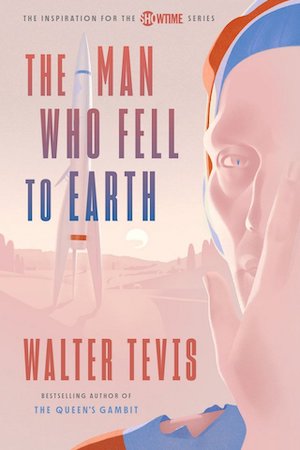
Anthea has highly developed technology but (thanks to some very poor decisions) almost no resources. Its population has dwindled until there are only three hundred surviving Antheans.
Earth, on the contrary, has an abundance of resources. Not that this would do Anthea any good, because:
- Earth lacks the ability to export its resources.
- Earth doesn’t know that Anthea exists at all.
Anthea is doomed, unless some ingenious way can be found to put Terrestrial resources at Anthean disposal.
The meager Anthean resources are sufficient to deliver one Anthean disguised as a human to Earth. Adopting the name Thomas Jerome Newton, his task is to parlay Anthean technological innovations into a fortune, which can then be used to finance Anthea’s salvation, quite possibly bringing global peace and prosperity to Earth as a side-effect. A worthy plan with only two flaws: Newton’s weakness for American vices and America’s profoundly paranoid security state.
As you know, The Man Who Fell to Earth was adapted to film, as were Tevis’ The Hustler and The Color of Money, while The Queen’s Gambit was adapted to television. The Hustler and The Color of Money are explicitly connected, while nothing in The Queen’s Gambit rules out it being in the same narrative universe. Do all four adaptations share the same continuity? Nobody in Hustler, Color, or Queen’s Gambit says they are Anthean, which is exactly what we would expect if they were undercover aliens…
The Far Side of Evil by Sylvia Louise Engdahl (1971)
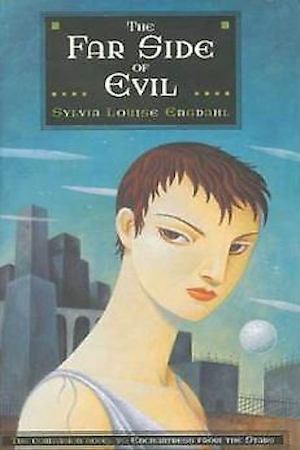
Planetary civilizations that develop space flight survive and thrive. Those that do not perish. The Federation is curious as to why some planets choose one path while others choose the other. The planet Toris, poised on the brink of choosing between maturity or doom, is a rare chance to observe the so-called critical stage.
Rather conveniently for the Federation, Toris’ natives are sufficiently humanoid that it’s trivial to disguise field agents Elana and Randil as locals before planting them as observers amongst the unsuspecting Torisians. Less conveniently for both Toris and the Federation, Randil is convinced that he can save Toris from itself—a direct contravention of Federation rules. In fact, Randil may be the catalyst for planetary doom.
What the heck is it about science fictional Federations and rogue field agents?
This is something of an inversion of the aliens-among-us trope. Technically, this is humans amongst aliens. Engdahl’s universe appears to produce a curious abundance of essentially human aliens, while Toris is suspiciously similar to Cold War-era Earth, as seen from an American perspective.
Ingathering by Zenna Henderson (1995)
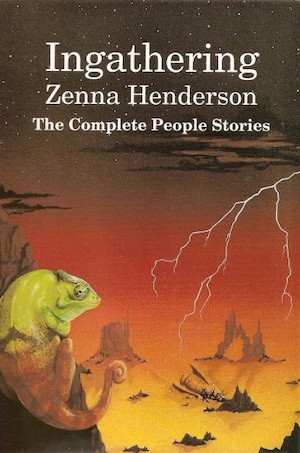
Forced to flee their doomed home world, a shipload of People reached the Earth in the late 19th century. The catastrophic landing scattered survivors across the American Southwest. Enough People survived to ensure the continuation of the People…at least for the moment.
Visually indistinguishable from Terrestrials, the People differ in very important respects. Humans developed technology. The People have psionic powers. Humans are often violent. The People are not. Therefore, when possible, the People live apart, in isolated communities. That this is not always possible, that the charade may someday fail, is a concern for the People, because on Earth “different is dead.”
Despite the gloomy tone of the above, the People stories often have happy endings. However, reaching them requires a lot of work.
The Melancholy of Haruhi Suzumiya by Nagaru Tanigawa (2003)
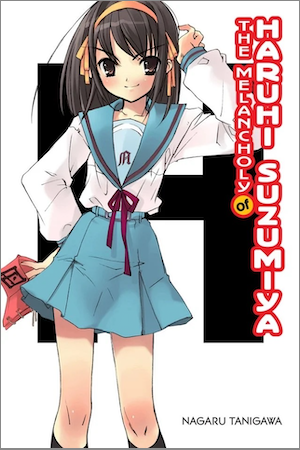
Young Haruhi had a horrifying revelation. She is only one insignificant human among billions of insignificant humans. Outraged at the injustice, Haruhi set out to pursue wonders. If time-travelers, sliders (people from alternate universes), psychic adepts, or aliens are on Earth, Haruhi’s SOS Brigade1 will find them.
Haruhi would be astonished to learn that of the SOS’s members (Mikuru Asahina, Itsuki Koizumi, Yuki Nagato, Kyon, and Haruhi herself), only Kyon is a mundane human. Mikuru is a time-traveler, Itsuki is an esper, and Yuki is the humanoid manifestation of the incomprehensibly alien Data Integration Thought Entity. As for Haruhi? She may well be a god whose whimsy could imperil existence, a being who warrants close monitoring.
A good part of the series’ arc involves Haruhi learning to be a better or at least less-bad person (or a better whatever the hell she is, something for which Mikuru, Itsuki, and Yuki lack consensus beyond “extremely dangerous”). This is the first novel in a series, which means that base-state Haruhi is comprehensively lacking in basic virtues such as kindness and empathy. She learns to be better as the series proceeds… albeit from a very low starting point.
Nyaruko: Crawling with Love! by Manta Aisora and illustrated by Koin (2009)

Earth! The universe’s only source of thionite delectable humans and delectable human products such as anime! Purloining humans and human creations for sale elsewhere in the galaxy is forbidden (or at least, regulated). Humans being unable to defend themselves, stalwart officers like Nyaruko must protect them. More specifically, Nyaruko must protect Japanese student Mahiro Yasaka.
Better known on Earth as Nyarlothotep, Nyaruko’s default form is an eldritch abomination, the smallest glimpse of which would surely drive all humans within eyeshot insane. Not ideal for undercover work. Happily, among her available forms is that of a silver-haired high-school girl—a perfect choice for infiltrating Earth before inadvertently unleashing chaos.
Readers may be surprised that there is a light novel series (and various adaptations thereof) in which a major character is a sympathetically portrayed Lovecraftian horror. These readers may be interested to learn that the Lovecraftian horror tabletop roleplaying game Call of Cthulhu is wildly popular in Japan… and also that there is at least one other work featuring a sympathetically portrayed Lovecraftian horror: Pochi Iida’s The Elder Sister-like One, in which Shub-Niggurath embraces the role of doting older sister to a forsaken orphan.
There are many tales in which aliens pass themselves off as human (or humans as alien)2. These are but a very few. This is usually where I encourage readers to mention other examples below: Please do!
However, I also would appreciate it if some reader could identify a book I bought from Scholastic in Grade 5 (so 1971–1972), which featured an alien boy able to pass as human because human minds refused to accept his manifest alienness and saw him as a normal boy. It isn’t Alan Mendelsohn, the Boy from Mars, because that wasn’t published until 1979. Any idea what it was?
- In the English translation, SOS stands for “Spreading excitement all Over the world with Haruhi Suzumiya Brigade”. Acronyms do not appear to be one of Haruhi’s strong points. ↩︎
- Especially on television and in movies, because hiring actors whose natural form causes viewers to perish in raving madness negatively impacts audience size. ↩︎










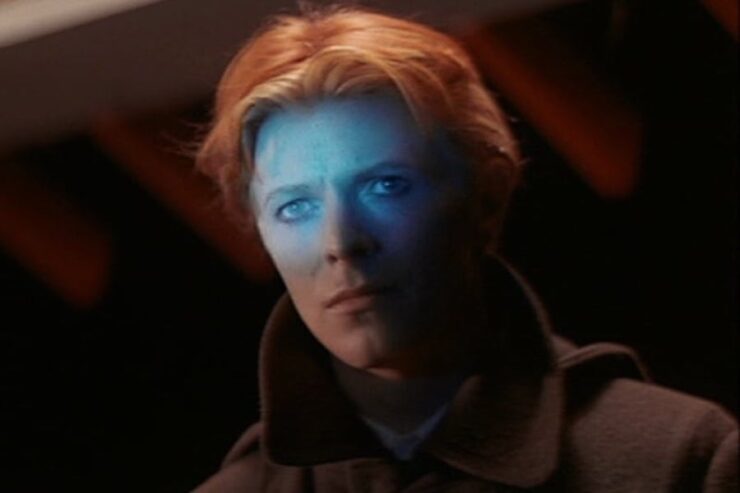
I’ve got a new Tevis head canon!
Fast Eddie’s broken thumbs force him to try chess hustling, where he’s schooled by femme fatale Beth Harmon and her otherworldly mentor, Thomas Jerome Newton.
Hilarity ensues, but everyone lives happily ever after.
Philip José Farmer’s The Lovers springs to mind, in that one half of the eponymous pairing is radically non-human, while the other half is radically oblivious. It ends badly, of course. I’ve said before that it comes across as a plea for honesty in relationships. Ladies, if you happen to be a giant insect masquerading as a human female, tell your boyfriend about it. Don’t just go around pretending to be French and hoping he won’t notice.
More recently, John Wiswell’s Someone You Can Build a Nest In features a non-human who can pass for human, in order to – well, they have more than one reason.
By any chance, was it The Forgotten Door by Alexander Key?
That was the first thing that came to my mind — I loved that book! — but I don’t think there was anything in there about Little Jon being anything other than human-appearing.
I feel as if Sheckley used this in more than one story, but “Tripout” springs to mind.
Papazian appeared, disguised as a human being. He checked quickly to make sure that his head was on right. “Nose and toes the same way goes,” he reminded himself, and that was how it was.
There is of course no shortage of video games featuring eldritch terrors from beyond masquerading as hoomans. In fact it seems to be a major subgenre.
There are a bunch of stories in Diane Duane’s Young Wizards series where wizards from other planets disguise themselves to accompany Nita, Kit, and Dairine on adventures around Long Island (or other parts of Earth). And there’s that subplot with Dairine and her alien prince boyfriend which is still unresolved.
Going back a few decades, I would also bring up Julian May’s Saga of Pliocene Exile (1980-84), written from the perspective of 2112 AD when Earth is but one planet of the Human Polity of the Galactic Milieu, but for nearly a century has been sending recidivists through a one-way time machine — where it turns out that a race of intergalactic nonhumans is already in occupation, and the plot strongly implies that descendants of these people, mating with the human exiles, survived 6 million years to become our ancestors (and also the origin of the Tuatha de Danaan). At the climax of book 4, THE ADVERSARY, the humans and the exotics build a reverse time gate to get back to — or in the case of some of the exotics, to escape to — 2112, and the following books (INTERVENTION et seq.) make it clear that those who returned were somehow reintegrated in modern society. Unlike the present-day exotics of the Galactic Milieu, the exotics of 6 million years ago are essentially humanoid in appearance, except for being very tall and allergic to iron.
I came here to mention May’s great series, but have been beaten to it! There’s also her Rampart Worlds trilogy (scandalously ignored by e-book convertors) which has a subplot where aliens undergo gene therapy to pose as humans for very nefarious purposes.
I remember the conclusion of the series a bit differently–I had forgotten about the civilians being evacuated at the end. The two very powerful metapsychic protagonists realized the fundamental problem that the exotics have (stunted metapsychic development due to <spoiler>), and travel the their home galaxy to help the much more civilized main population with the problem. (the exotics on earth were also recidivists–what is it about the Pliocene Earth that says “dump your violent assholes here!”) .
The later series eventually reveals that the oldest race in the Milieu are the exotics from Pliocene Exile, 6 million years after the protagonists fixed their metapsychic problem.
As a child I read Alexander Scott Key’s Escape to Witch Mountain (which was much better than the disappointing Disney Movies), where orphans Tony and Tia escape an orphanage to find their people, who are hiding themselves and their powers. It’s only after most of the book that they realize their people aren’t even human.
I remember that movie! There’s been a lot of discussion about whether Witch Mountain was influenced by the People stories of Zenna Henderson – the date above (1995) is for that particular anthology, but the stories were first written and published in the 1950s and early 1960s.
(The movie of “The People” was made in 1972 with William Shatner. It’s … terrible.)
(I stumbled over “The Anything Box” many years ago, and got hooked.)
I enjoyed Joe Haldeman’s Camouflage, which, if I remember, has two different aliens masquerading as humans. Both shape-changey in different ways. One is a sadistic predator, the other… nice? It won awards. I remember liking the heck out of it and marveling that Haldeman just keeps on being good. It was written in maybe 2005, and some of the narrative takes place in the 2020s, and involves the US sliding into authoritarianism … so I mean it’s pretty far-fetched stuff.
I’m fascinated to know what your mystery book is. Could it be Alien from the Stars? I haven’t read that one, but I was so intrigued by your description that I went Googling around and found it. It’s Putnam, not Scholastic, but the time-frame works. https://www.amazon.com/Alien-Stars-Jeff-Jean-Sutton/dp/B0006CF9I0
Donald Wollheim’s short story “Mimic” features an insect that has evolved a morphology (and size, and to some degree behaviour) that allows it to pass for a human being in urban environments, if nobody looks very closely. It isn’t an alien, however – it evolved here on Earth – and it doesn’t exhibit much intelligence.
The Space Ship Under the Apple Tree, by Louis Slobodkin?
Surprised no one mentioned the Coneheads yet.
“Join us for the consumption of mass quantities! Grid-like breakfast slabs… seared strips of swine flesh and flattened chicken embryos. I will enjoy it.”
Or Third Rock from the Sun
I suspect that your book may be Patricia Wrightson’s 1965 book Down to Earth, which I think I got from Scholastic. It involves a strange boy, Martin, who claims to be from outer space, squeezes into implausibly small spaces, and glows green while he’s sleeping. He explains that the human children who find him merely perceive him to be like them, since their minds can’t grasp his true form. On the other hand, he has a similar problem, perceiving them to be like him.
That does sound like it! I don’t see a Scholastic edition but maybe I got that detail wrong.
The book is set in Sydney, Australia. Vg gheaf bhg gung nyy bs gur rppragevp nqhygf gung gur cebgntbavfgf unir rapbhagrerq ner nyfb nyvraf.
How about Eight Days of Luke (1975) by Diana Wynne Jones, in which the young hero is befriended by another boy called Luke, who is not entirely what he seems, but is in fact somewhat mythological in origin. Hilarity (and a certain amount of arson) then ensue…
For a more SF version, we have of course one Clark Kent, who is definitely not from around here. And lots of others from the comics, of course, not least the movie version of Thor, who is a human-looking alien that can’t prove he’s alien without his powers.
Several characters in Saunders’s Commonweal series come to mind.
I read the Henderson stories in high school and regularly return to my old paperback copies for a good comfort read (they were an especially good balm during the lockdown). I’ve always had a soft spot for lower wattage Saturday Evening Post era sci-fi and these really hit the sweet spot. The Francis Ford Coppola produced Movie of the Week with William Shatner and Kim Darby is a modest but rewarding watch if you’re having a bad day.
I’ve been circling Tevis for awhile now and may finally get to him this summer.
Seanan McGuire’s InCryptid series is urban fantasy rather than SF, but has the other-dimensional Johrlac posing as humans. Johrlac are actually psychic parasitic wasps, and their human forms are known as “cuckoos”, since Johrlac children are planted in human homes and use their psychic powers to ensure they are loved and cared for until such time as they mature into wasp form and…well…
Wyndham’s Midwich cuckoos (McGuire’s inspiration) are very definitely aliens passing as human, and not very well as they grow older.
It could be argued that the human-Oankali hybrids in Octavia Butler’s Adulthood Rites and Imago are passing as human, since the remaining humans are xenophobic and immediately distrust and fear anyone who starts showing Oankali characteristics.
I’m a big fan of Alan Tudyk’s “Resident Alien” which is about to release its fourth season.
Filmed here on Vancouver Island, partly in Pamela Anderson’s home town.
Neither of these, technically, fit this category, but Roger Zelazny’s Doorways in the Sand has a major character who is an alien agent disguised as a black cat. And Frank Herbert wrote The Green Brain, in which an intelligent hive of mutated insects can impersonate humans well enough to pass through vibration barriers designed to keep insects from escaping the jungle,
No mention of Uncle Martin, from My Favorite Martian?
Nobody’s mentioned literature’s greatest example of aliens among us, masterfully blending into our society.
Ford Prefect.